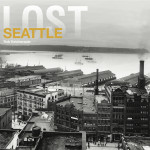Letter in reply to editorial column in the Sunday, July 18 2004 edition of the Seattle PI:
This is part of the special feature Freeway Box, showcasing my old life next to freeway viaducts.
Boy, I'm sorry I didn't write to you earlier about the viaduct. Not everyone thinks it's a great idea to replace it with another raised structure through downtown.
Folks need to be careful to be certain that they know what they're asking for. If we replace it with another viaduct, it will be wider, cutting a larger swath through the waterfront. It's necessary for safety standards. The lanes are currently too narrow, and there are little or no shoulders. The roadway just can't be built the same way and meet federal safety requirements.
What I'm waiting for are the sounds of consternation, as everyone tries to enjoy their view and discovers sound walls up and down the viaduct. Currently only suburban freeways are new enough to sport sound walls which protect nearby residents and businesses from the constant rush of freeway noises. Downtown Seattle, with the most dense use of anywhere in the region, has virtually no sound walls. If another viaduct is built, I'm going to expect to be able to walk through the waterfront and carry on a conversation, something that I currently can't do. And drivers should expect to not be able to see.
This isn't the first time that I've heard about tunneling as a plot to gift land to "developers." I'm not sure who these "developers" are. Certainly if the viaduct is removed, all of the underutilized properties along it including empty lots or surface parking will be redeveloped. As a downtown resident, I'm excited every time an underutilized lot is turned into a hotel, office building, apartment or condo. It means more neighbors, more customers for my neighborhood's businesses, more opportunity for interesting new places to go. Not every development meets expectations, but I think I would prefer a poorly realized or designed building to an empty lot filled with refuse or another depressing slab of asphalt.
I've been following viaduct planning for about three years. I've heard the voices of public officials, planners, neighborhood activists, the freight industry, bike advocates, and suburban users of the corridor among others. Strangely, I've never heard anything from "developers." They aren't the voice lobbying for removal of the viaduct. This isn't a nefarious plot to take public land. If you've looked at the plans, you would know that parks will be made with what little land is left after surface streets and streetcar lines are built.
On a related note, I'm curious to know how much of the viaduct's right of way was condemned and taken from private individuals or railways to begin with?
